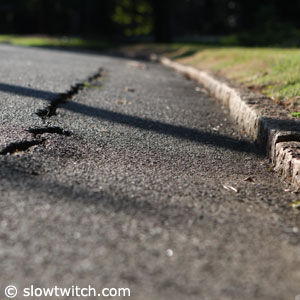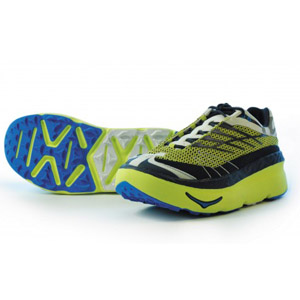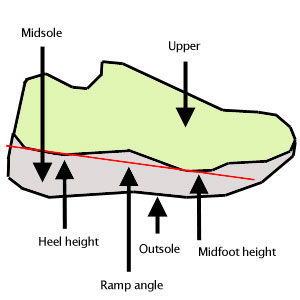Concrete or Asphalt?
Ever since becoming a triathlete, I have been aware of the supposed dangers of running on concrete surfaces, eschewing safer sidewalks for running on the shoulder of a road against traffic, hopping curbs as if every step on concrete might be my last. As readers of my past articles may have noted, I like to challenge some commonly held beliefs and back up my position with scientific evidence.
So I might as well let you know up front that the hardness difference between concrete and asphalt is insignificant when running in shoes, because the cushioning afforded by shoes far exceeds any cushioning provided by those surfaces. When moving to grass or dirt, the contribution of those surfaces to reducing ground impact begins to play a much larger role. It's also clear that runners have many personal experiences running on varied surfaces, and in researching this article, it became clear that some runners are convinced they can sense the impact difference between concrete and asphalt.
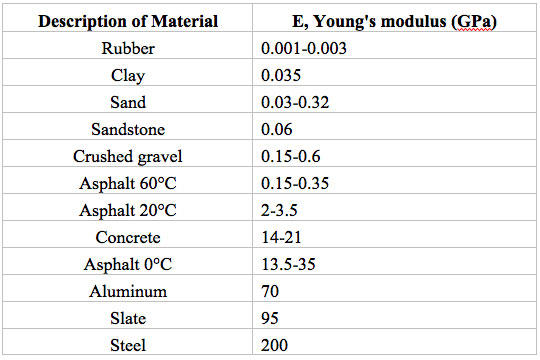
At the end of the day it's up to you, but science supports that the most likely running injury you'll get from running on the road is getting hit by a car, and that concrete sidewalks are probably safest, provided you watch out for possible uneven surfaces.
Surface Hardness and Measurements
What is it that makes a surface "harder" than another? It is the resistance to being deformed elastically when a force is applied to it. This is a non-permanent deformation, and scientifically is quantified by the "modulus of elasticity". Young's modulus (E) describes tensile elasticity, or the tendency of an object to deform along an axis when opposing forces are applied along that axis; it is defined as the ratio of tensile stress to tensile strain. It is often referred to simply as the "elastic modulus".
The above chart is a summary of the approximate elastic modulus for various surfaces. What do these numbers mean?
Mathematically, concrete absorbs 10 times less energy than asphalt at 20°C. With a typical runner of 70kg landing with about 3-5x body weight of force, neither concrete nor asphalt compress any measurable amount. Practically, there is no material difference when one begins to consider the compressibility of the foot and running shoe material, as we will explore shortly. It is also worth noting that while materials like concrete as subject to fracture under stress, it should be obvious that the loads to which these materials are subject by runners fall way below this threshold, and for our purposes these materials can be considered to be elastic in this part of the stress-strain curve. Also note that cold asphalt has about the same hardness as concrete. Rubber is at least 14,000 times less hard than concrete.
Here is a simpler test you can try for yourself: Bounce a golf ball off concrete, asphalt, and dirt. The rebound distance will provide an indication how much energy is absorbed by the surface and how much energy is returned to the golf ball. A surface that returns more energy to the ball will all return more energy to your legs and consequently will feel "harder". If you do this experiment, you will find that asphalt and concrete cause the ball to bounce to nearly the same height.
Running Shoe Shock Absorption: The Midsole
Most runners tend to wear shoes, and we all know that the added material beneath our feet act as cushioning, along with the natural cushioning on the soles of our feet. Commonly used in shoes are viscoelastic materials, present in the midsole. These materials are usually known chemically as polyethylene, polyvinyl chloride, polyurethane, among others. As with other elastic materials, these substances provide an effective means to redistribute the pressure underfoot. Since energy cannot be "lost", what occurs is the spread of energy over a greater amount of time and release of some energy in the form of sound and heat. The reduction of overall pressure reduces local pressures and stress on the foot and other skeletal structures as the shockwave of each step promulgates upward through the body. This shockwave can damage soft tissue. Reducing the severity of the impact has been shown to improve overuse injuries including joint pain, stress fractures and possibly even osteoarthritis. In healthy individuals, a 10-20mm pad of fat on the bottom of the foot acts as a "viscoelastic shock absorber". Age, disease, and medication (ie- injected corticosteroids) can degrade the fat pad.
Artificial viscoelastic materials can replace or improve shock absorption. Studies have found that softer foam materials are effective if they are used in significant thickness but tend to deteriorate rapidly with use and can "bottom out" under load. It has been found that insoles that employ multiple materials in concert tend to afford the best overall performance.
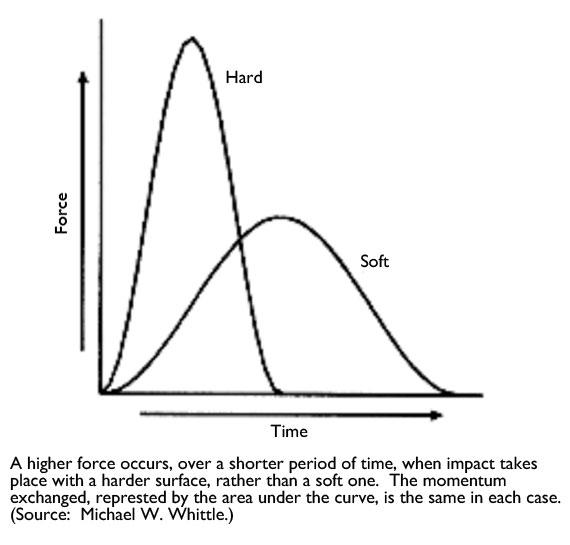
From a practical standpoint, estimates for compression of the heel fat pad during heelstrike range from 3mm to 8mm. It has also been noted that heel fat pad compression and midsole compression are related, and that a thicker midsole will cause less compression of the heel pad, so the absolute values are not additive. Barefoot running takes full advantage of the fat pad on the bottom of the foot. Contrast the combined deflection of the sole and foot and the deformation for asphalt or concrete and one quickly sees the magnitude of the difference that the foot unit as a whole – insole and fat pad – contribute versus the compression of hard running surfaces.
Impact on Running Form
Researchers have done more than to quantify the different hardness of running surfaces. Dixon et al tested runners on several surfaces and determined that the surface itself did not change the peak impact forces. That is, the amount of force runners "measured" did not vary based on the surface they ran on. What changed was the way they ran. Initial joint angles, peak joint angles, and peak joint angular velocities were all observed to change depending on the surface. Another study (Ferris et al) found that changing the surface caused a change in leg stiffness. By adjusting leg stiffness to accommodate surface stiffness, the runners maintained similar locomotion mechanics on different running surfaces.
Bishop et al compared running with shoes and running barefoot, and the relative stresses that places on the legs. They found that runners wearing shoes exhibited much stiffer legs than barefoot runners, and that there was no difference between high and low cost shoes in terms of their effect on body mechanics (in this particular study). Their data support the supposition that footwear causes changes in the limb during a dynamic task such as running.
Other Considerations
There are some other possible differences between asphalt and concrete that can make them different running surfaces:
Temperature of asphalt: As asphalt heats, it softens. However, research shows little variance in harness until the surface temp reached 70 Celsius, which would only happen on scorching hot days. Concrete does not soften in the heat.
Camber of the surface: Asphalt roads are crowned, where the center of a road will be higher then at the edges, to allow for drainage. By running on any part of the road other than the crown, one leg will always be higher than the other.
Surface smoothness: Old asphalt is usually a rougher surface than concrete, while fresh asphalt can be a smoother surface. Rough surfaces tend to absorb sound better, and so it's possible that shoes may sounder quieter on asphalt than on concrete, leading to the perception that it's softer. Also, asphalt lacks expansion joints and typical surface imperfections characteristic of sidewalks with curbs, etc…which can lead to a smoother and more regular gait.
Conclusion
The difference between concrete and asphalt is a bit like the difference between a standard HDTV and higher resolution TV, where the limiting factor becomes the eye's ability to observe the difference. The difference can be measured, but the difference is not significant in the greater context of the situation. In the case of running, both concrete and asphalt are very hard and deflect very little. The fact that one deflects a tiny bit more than the other scientifically does not translate to an observable difference in impact, especially when running is considered to include the impact absorbed by a running shoe and the sole of the foot.
The compressibility of rubber, EVA and a sock have considerably more contribution to the impact transmitted to the foot within the shoe than the difference between concrete and asphalt. Consider that the difference in hardness between concrete and asphalt is equivalent to adding less than 1mm of extra rubber to the sole of a shoe.
Beyond these hard surfaces, there are significant differences between road and track, trail, grass and sand. I would submit therefore that the goal of a runner trying to reduce the hardness of a surface explore these other options.
For example, dirt trails have other benefits too, working the body's proprioception and dynamic lateral movements and stimulating the brain with changing conditions – reconnecting with nature, some might say. Barefoot running on grass or sand is another combination that is sure to reduce the force impact and trigger further changes in running form.
As studies have shown, our bodies adapt to running surfaces. Provided good biomechanical form is maintained, any running surface will work. It's also nearly impossible to change somebody's mind once they have made it up. You may disagree based on your personal experience – that's fine. As for me, I'll stick to the dirt trails and looking for mountain lions, or leaving footprints on the beach.
References
Bishop M, Fiolkowski P, Horodyski M. J Athl Train. 2006 Oct-Dec; 41(4): 387–392.
Dixon SJ, Collop AC, Batt ME, Surface Effects on Ground Reaction Forces and Lower Extremity Kinematics in Running. Medicine and Science in Sports and Exercise 2000, 32(11):1919-1926
Ferris D et al. Running in the real world: Adjusting Leg Stiffness for Different Surfaces. Proc.R.Soc.Lond.B (1998) 265, 980-994
Whittle M. The Use of Viscoelastic Materials in Shoes and Insoles: A Review. Chattanooga, Tennessee www.impacto.ca
Obrzud R. Truty, A.THE HARDENING SOIL MODEL – A PRACTICAL GUIDEBOOK Z Soil.PC 100701 report, revised 31.01.2012
Jonathan Toker is a Canadian elite-level runner and triathlete. He received a Ph.D. in organic chemistry from The Scripps Research Institute in 2001, and raced in the professional ranks as a triathlete for 5 years and now races trail running. Dr. Toker worked as a scientist in the biotech industry for 5 years prior to launching his unique SaltStick Electrolyte Capsule and Dispenser lineup.


